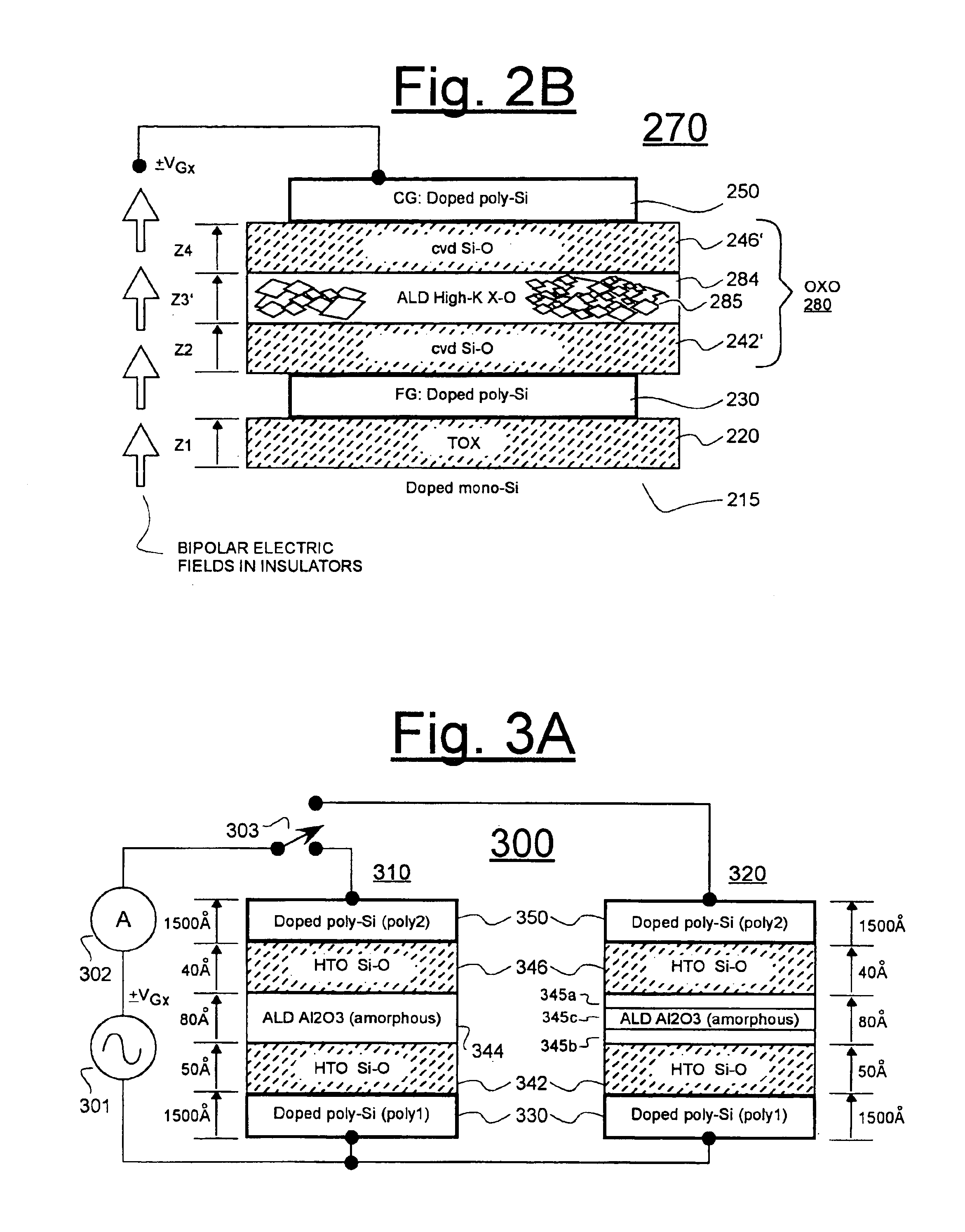[0022]More specifically, in accordance with one aspect of the present disclosure,
nitrogen atoms are incorporated into
amorphous metal oxide compositions (X(a)—O) such as those compositions which contain: amorphous aluminum oxide (AlO(a)), amorphous
hafnium oxide (HfO(a)), amorphous
titanium oxide (TiO(a)), and / or amorphous
tantalum oxide (TaO(a)) while the X(a)—O composition(s) substantially remain at relatively low temperature (e.g., less than about 330° C.), this being done so as to increase the break down
voltage and / or reduce the leakage current of one or more of these amorphous constituents. The temperature(s) of the nitridation process is( / are) maintained below the recrystallization temperature(s) of the constituent amorphous metal oxides so that the high-K metal oxide(s) will substantially retain its ( / their) amorphous structure(s) during nitridation and so that they will not develop large numbers of
crystal grain boundaries or otherwise undergo undesirable phase changes. Large
crystal grain boundaries are undesirable because they can serve as areas of amplified
electric field intensity and / or as regions where conductive impurities aggregate and they can thereby promote premature voltage breakdown or excessive current leakage. Other phase changes to the amorphous structures of the high-K metal oxides may also be undesirable because designers of
mass production devices wish to obtain consistent
dielectric constant values from one device to the next. By keeping temperature below a critical one or more recrystallization temperatures during the nitridation process, substantial disruption of the amorphous structures of a corresponding one or more of the high-K metal oxides may be avoided while the benefit of nitridation is obtained.
[0024]In accordance with a second aspect of the present disclosure, a downstream-
microwave plasma reactor is used for introducing the
nitrogen atoms at relatively low temperature (e.g., less than 330° C., this being low relative to furnace nitridation) into top and bottom surface regions of one or more
layers of the amorphous metal oxide compositions while leaving an interim region, between the upper and lower regions, less disturbed. Different
plasma reactors have different distribution profiles for introducing ions into thin layers of
dielectric material. It has been found, for example, that the downstream-
microwave processing mode of the GaSonics PEP Iridia DL™
system (GaSonics is now part of Novellus of California) tends to distribute
nitrogen atoms across a 100 Å thick,
dielectric layer with a distribution profile that has plural concentration peaks. More specifically, for distribution of nitrogen in
silicon dioxide it was observed that a relatively low concentration of injected nitrogen occurs around the 10 Å-40 Å depth range and relatively much higher concentrations of injected nitrogen occur around the 0 Å-9 Å range and the 45 Å-60 Å range. Other types of nitridating plasma reactors have been found to have more uniform distribution for injected nitrogen across the roughly, 0 Å-100 Å depth range of
silicon dioxide. For reasons that may not yet be fully understood, a multi-concentration peak injection of nitrogen atoms into a 60 Å thick, amorphous aluminum oxide layer appears to significantly improve resistance to dual-polarity breakdown. (Dual polarity refers to the challenging of the dielectric material's
breakdown strength for both positive and
negative voltage application across the
dielectric layer.) It is possible that the increased nitrogen concentration at the top and bottom surface regions of the amorphous AlO layer seals
oxygen atoms in the middle of the so-nitridated metal oxide layer an thereby preserves high-K performance. Alternatively or additionally, it is possible that the multi-peak nitrogen concentration profile between the top and bottom surface regions of the so-nitridated metal oxide layer behaves as a strong barrier to
electron tunneling and thereby functions to reduce
electron tunneling effects and as a consequence, improve the anti-leakage characteristics of the so-nitridated metal oxide layer. Different amounts of tunnel leakage may occur when an asymmetrically nitridated
dielectric layer is subjected to stressing E-fields in both the positive and
negative voltage directions. Irrespective of the
correctness of such conjectured mechanisms,
improved performance was observed when a below-described,
dual frequency, downstream-
microwave plasma reactor was used for incorporating nitrogen atoms into a high-K metal oxide layer.
[0025]In accordance with a third aspect of the present disclosure, a
dual frequency, downstream-microwave
plasma reactor is further used for introducing
fluorine atoms at relatively low temperature (e.g., less than 330° C., this being low relative to furnace driven introductions) into the amorphous, metal oxide layer (e.g., AlO(a) layer) prior to introducing the nitrogen atoms. It is believed that the introduced
fluorine atoms break or weaken metal-to-
oxygen bonds (X—O bonds) in the amorphous, metal oxide layer (XO(a)) and thereby encourage the formation of a greater number of metal-to-nitrogen bonds (X—N bonds) when the nitrogen atoms are subsequently introduced, also at relatively low temperature. The relatively low temperatures of the combined fluorination and nitridation plasma treatments are believed to help preserve the amorphous character of the metal oxide layer. This in turn, it is believed, works to inhibit the formation of large, field-concentrating grain boundaries in the inner regions of the amorphous metal-oxide structure and thereby also helps to inhibit premature electric insulation breakdown.
 Login to View More
Login to View More  Login to View More
Login to View More 


